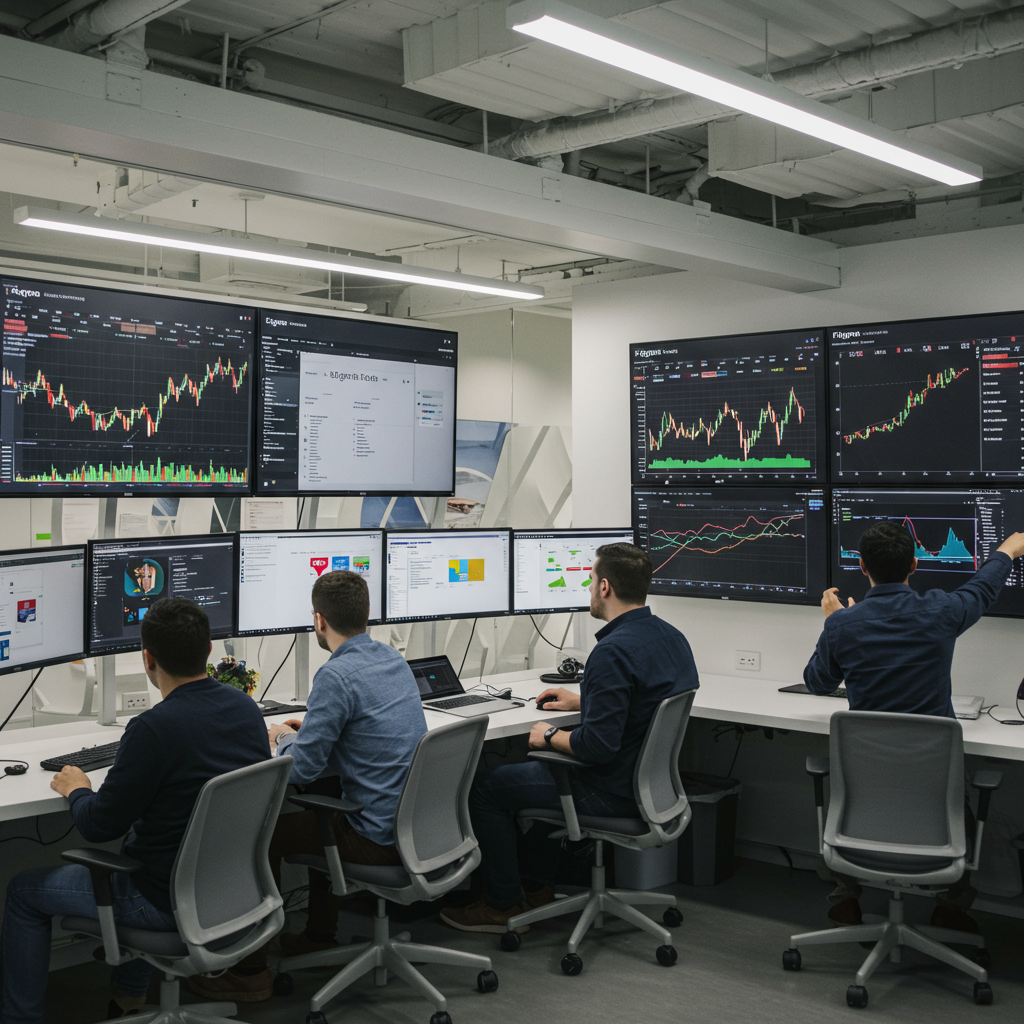Collaborative design software leader Figma is taking a significant leap into the public markets. The company officially filed for an Initial Public Offering (IPO) on Tuesday, signaling its intent to list shares on the prestigious New York Stock Exchange (NYSE). Trading will commence under the familiar ticker symbol “FIG,” a move long anticipated by investors and the tech industry alike. This IPO marks a pivotal moment for Figma, positioning it for accelerated growth and strategic expansion, notably including plans for significant acquisitions.
The Path to Public: From Private Valuation to NYSE
Figma’s journey to becoming a publicly traded entity has been closely watched, especially following a dramatic turn of events in late 2023. Adobe, a major player in the design software space, had proposed acquiring Figma in a deal valued at a staggering $20 billion. However, this acquisition agreement was ultimately terminated due to mounting regulatory concerns, particularly in the United Kingdom. Despite the setback, Figma received a substantial $1 billion termination fee from Adobe, providing a significant cash infusion.
Prior to the IPO filing, Figma was valued at $12.5 billion in a tender offer conducted just last year. The confidential IPO filing with the U.S. Securities and Exchange Commission (SEC) was first announced in April, setting the stage for Tuesday’s public submission of its S-1 prospectus. While the exact number of shares to be sold or the initial price range has not yet been disclosed, the filing provides a detailed look at the company’s financial health and strategic vision.
Impressive Financial Performance Fuels Public Ambition
Figma’s decision to enter the public market is underpinned by robust financial performance. According to the company’s prospectus, revenue in the first quarter demonstrated impressive year-over-year growth, climbing 46% to reach $228.2 million, up from $156.2 million in the same period a year prior. This rapid top-line expansion translated into strong profitability. The company recorded a net income of $44.9 million in the first quarter, a significant increase compared to $13.5 million during the corresponding period the previous year.
Growth wasn’t limited to revenue and profit; Figma also saw substantial expansion in its customer base, particularly among its most valuable clients. As of March 31, 2025, Figma served approximately 450,000 customers globally. A key indicator of its success in the enterprise market is the growth in large accounts: 1,031 customers were contributing at least $100,000 in annual recurring revenue (ARR). This represents a remarkable 47% increase from the number of such high-value customers a year earlier. The company boasts a prestigious list of clients, including major names like Duolingo, Mercado Libre, Netflix, Pentagram, ServiceNow, and Stripe.
Strategic Leadership and Vision
Leadership transitions also precede the IPO. Bill McDermott, the accomplished CEO of ServiceNow, has joined Figma’s board of directors. According to the filing, McDermott will leverage his extensive experience, which includes serving on Zoom’s board and continuing as ServiceNow’s chairman, to guide Figma through its next phase of growth as a public entity.
Figma was founded in 2012 in San Francisco by CEO Dylan Field, 33, and Evan Wallace. Field’s journey included time at Brown University before he notably took a Thiel Fellowship, a program established by Founders Fund partner Peter Thiel that provides young entrepreneurs with funding and support to pursue innovative projects outside traditional academic paths. This foundational experience shaped Field’s entrepreneurial drive. As the largest individual owner of Figma, Field holds a significant stake, controlling 51.1% of the voting power ahead of the IPO.
Bucking the Trend and Sharing Ownership
In a letter to prospective investors, Dylan Field articulated the strategic rationale behind taking Figma public now. He stated it was “time for Figma to buck the trend of many amazing companies staying privately indefinitely,” a reference to high-valued tech giants like Databricks, SpaceX, and Stripe that have remained private for extended periods. Field highlighted several anticipated benefits of becoming a public company, including improved corporate governance (“good corporate hygiene”), enhanced brand visibility, increased liquidity for shareholders and employees, a stronger currency for potential acquisitions or talent recruitment, and broader access to capital markets.
Crucially, Field emphasized a desire to share Figma’s success more widely. “More importantly,” he wrote, “I like the idea of our community sharing in the ownership of Figma — and the best way to accomplish this is through public markets.” This sentiment underscores a commitment to align the interests of users, employees, and investors through shared ownership in the company’s future success.
IPO Market Momentum and Venture Capital Returns
Figma’s IPO surfaces amid a thawing in the technology IPO market, which had experienced a significant dry spell since late 2021. Rising inflation and increasing interest rates had previously pushed investors away from riskier assets like unproven public tech stocks. While market sentiment has fluctuated, particularly following political and economic announcements, activity has seen a recent pickup.
Several notable companies have debuted on the public markets recently, indicating renewed investor appetite. Stablecoin issuer Circle saw its value double in its early June debut and has since surged dramatically. Online banking firm Chime and healthcare tech company Hinge Health also went public in June and May, respectively. Artificial intelligence infrastructure provider CoreWeave, which debuted in March, experienced a substantial jump in June and has quadrupled its initial offering price. Buy now, pay later company Klarna and ticket marketplace StubHub also filed for U.S. IPOs earlier this year. Figma’s entry further solidifies this trend of tech companies accessing public capital. The IPO is also poised to provide much-needed returns for venture capital firms that invested early in Figma, helping to validate their portfolios after a multi-year slump in exits. Key venture shareholders include Index Ventures (17%), Greylock (16%), Kleiner Perkins (14%), and Sequoia (8.7%) before the offering.
Strategic Expansion Through Acquisitions and Diversification
A core component of Figma’s strategy as a public company involves aggressive expansion, particularly through acquisitions. Dylan Field stated investors should “expect us to take big swings” in this area. The company has already demonstrated this approach with several recent deals. In April, Figma acquired the assets and team of an unspecified technology company for $14 million. That same month, it acquired an unnamed company specializing in content management system (CMS) software for $35.5 million. Further reinforcing this strategy, design software startup Modyfi announced it would join Figma in April. Most recently, Figma revealed in a June blog post that it acquired Payload, another content management software startup backed by notable investors including Google and MongoDB. These moves signal a strategic push to build out Figma’s capabilities beyond its core collaborative design platform, potentially integrating content management and other complementary tools into its ecosystem.
Beyond traditional software expansion, Figma has also begun exploring investments in digital assets. In 2024, Figma’s board authorized a $55 million investment into a Bitwise Bitcoin exchange-traded fund (ETF). As of the end of March, this holding had appreciated to $69.5 million. In May, the board approved another significant investment, directing $30 million towards Bitcoin, which Figma ultimately used to purchase USD Coin, a stablecoin pegged to the U.S. dollar. These investments highlight a forward-thinking approach to managing corporate treasury and exploring new financial avenues.
Competitive Landscape and User Base Dynamics
Figma operates in a highly competitive market, facing pressure from established players and newer entrants. While the company’s filing noted “intense competition” and the risk of losing market share, it did not name specific competitors within the document itself. However, industry analysis often points to companies like Adobe (with products like Photoshop and Illustrator) and Sketch as key rivals. Figma distinguishes itself with its web-based, real-time collaborative environment, making it particularly attractive for distributed teams working on digital products.
The company’s reach extends far beyond traditional designers. Figma reports over 13 million people use its platform every month, with only about one-third identifying primarily as designers. This broad adoption indicates its utility for product managers, marketers, writers, and other stakeholders involved in the digital product lifecycle. Geographically, Figma has a strong international presence; around 85% of its monthly users were located outside the United States as of March 31. However, a larger portion of its revenue, 53%, still originated from outside the U.S., suggesting different monetization strategies or user demographics across regions.
Further diversifying its product portfolio, Figma announced “Figma Sites” in March. This new tool allows users to transform their designs directly into functional websites. This product, alongside its recent acquisitions, illustrates Figma’s strategic move to expand its offerings and capture a larger share of the digital creation workflow, moving beyond its core design collaboration service. The company holds a strong financial position entering the IPO, reporting $1.54 billion in cash, cash equivalents, and marketable securities at the end of March, providing ample resources for future investments and strategic maneuvers.
The IPO offering is being led by a consortium of major investment banks, including Morgan Stanley, Goldman Sachs, Allen and Company, and JPMorgan Chase, serving as joint lead book-running managers. These financial institutions will play a critical role in pricing the shares and managing the offering process.
Frequently Asked Questions
What is Figma’s stock ticker symbol and where will it be listed?
Figma plans to list its shares on the New York Stock Exchange (NYSE) under the ticker symbol “FIG.” The company officially filed its S-1 registration statement with the SEC on Tuesday, outlining its financial performance, business strategy, and risks ahead of the public offering.
Why is Figma going public now, especially after the Adobe acquisition fell through?
CEO Dylan Field stated the decision was made to move away from the trend of successful companies remaining private indefinitely. Benefits include improving corporate structure, increasing brand awareness, providing liquidity for employees and investors, having a stronger currency for deals, and gaining better access to capital markets. The failed Adobe deal may have accelerated the path to IPO as an alternative way to provide liquidity and fund future growth plans, such as acquisitions.
What are Figma’s key strategic plans now that it’s becoming a public company?
Figma’s leadership, specifically CEO Dylan Field, has indicated that investors should expect the company to “take big swings,” particularly through strategic acquisitions. The company has recently acquired several firms, including one focused on content management systems (CMS), signaling a move to integrate new capabilities into its platform and potentially diversify its offerings beyond core design tools. They also plan to continue investing in areas like cryptoassets.
Conclusion
Figma’s IPO filing on the NYSE marks a significant milestone for the company and the broader tech market. Armed with strong financial performance, a rapidly growing enterprise customer base, and a clear vision for strategic acquisitions and diversification, Figma is poised to leverage the public markets to accelerate its growth. As the company transitions from a highly-valued private entity to a publicly traded stock, investors and users alike will be watching closely to see how this design giant navigates intense competition and executes its ambitious plans on a global stage. The move provides needed liquidity for early investors and equips Figma with the resources and platform to pursue its next phase of expansion.
Word Count Check: ~1160 words




